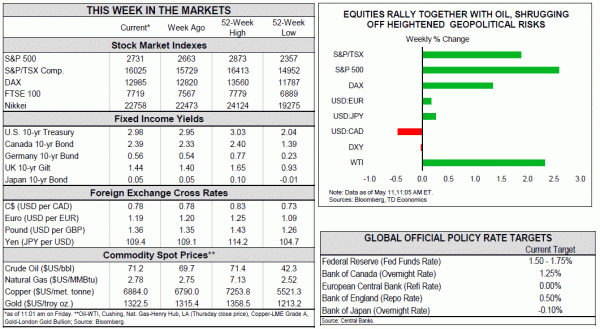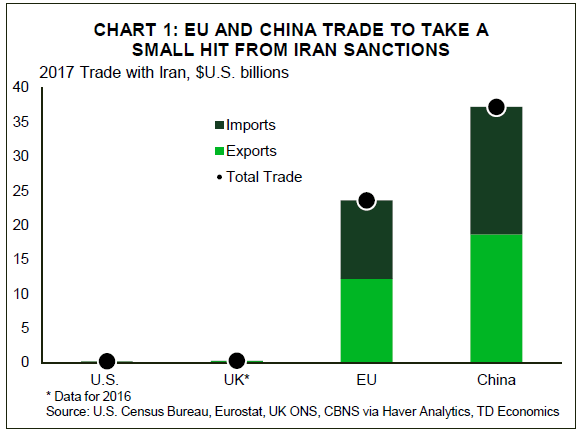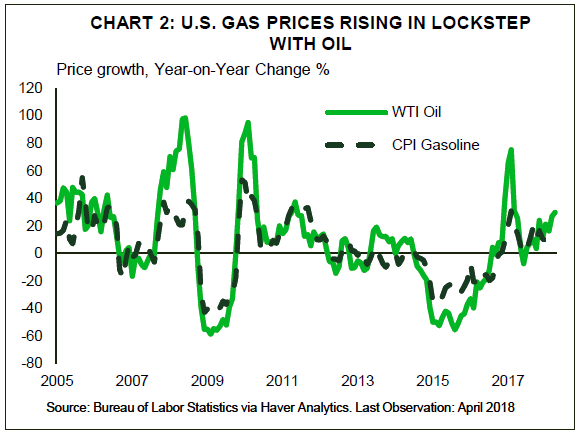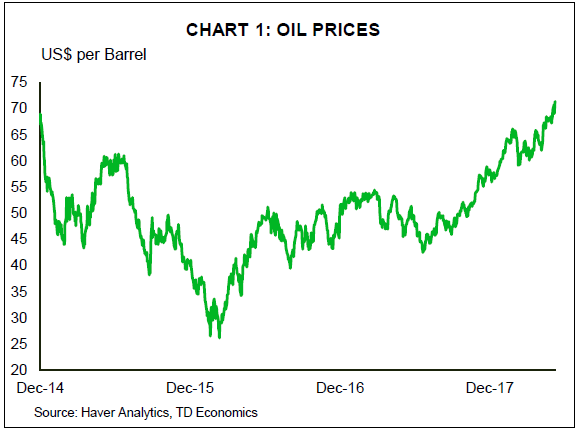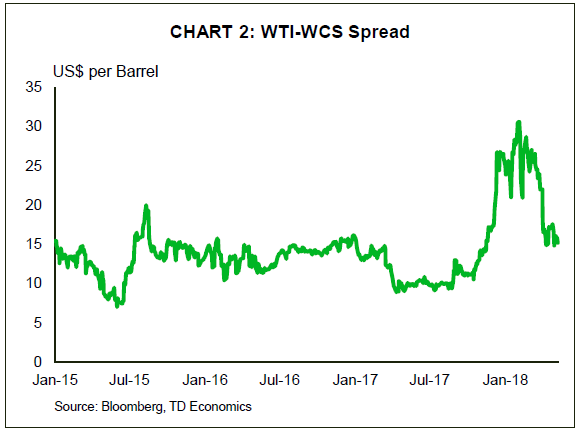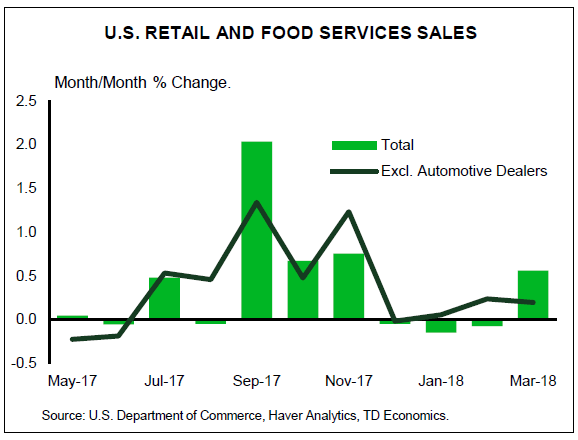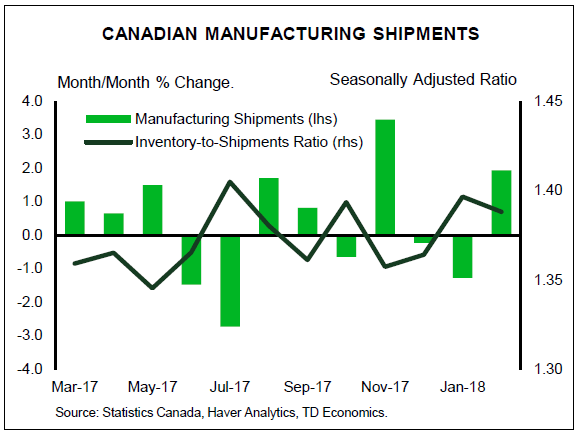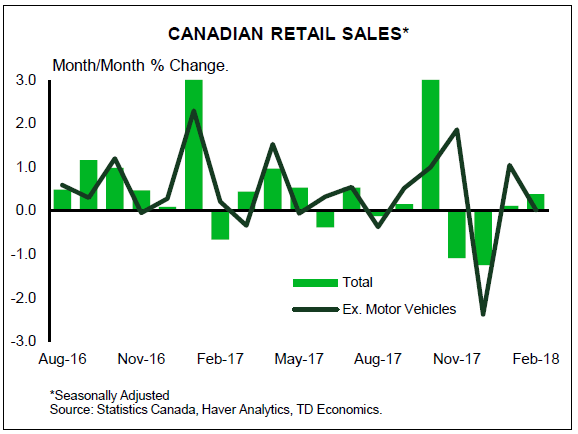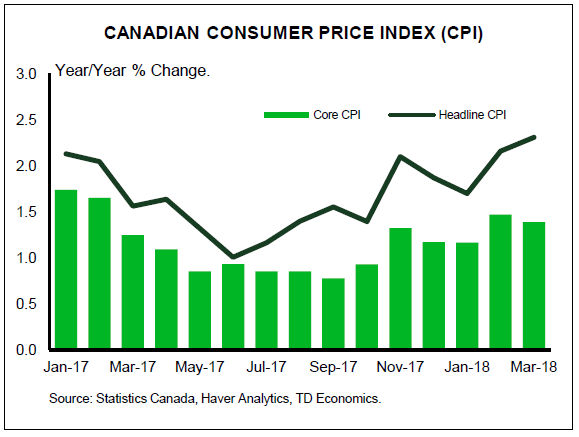U.S. Highlights
- Domestic equity markets shrugged off news that the U.S. administration is pulling out of the current Iran deal while leaving the door open to renegotiation.
- WTI oil rose for a fifth consecutive week. Rising U.S. gasoline prices helped drive headline inflation to 2.5% y/y, the fastest pace of price growth since February 2017.
- A loss of momentum in underlying inflation in April should help reduce concerns that the Federal Reserve isn’t moving fast enough to cool a hot U.S. economy.
Canadian Highlights
- Crude oil prices hit a 3½ year high this week, with the WTI benchmark hitting US$71 per barrel. While expectations of a U.S. withdrawal from the Iran nuclear agreement have helped to bid up prices recently, the actual impact on the oil market is likely to be limited.
- Housing starts slowed to 214k in April, while employment was flat. The unemployment rate held at 5.8%, while wage growth came in above 3% for a fourth consecutive month.
U.S. – Upping the Stakes
Events this week remind us of how uncertain the world can be at times, and how unpredictable financial markets can be. On Tuesday President Trump announced that his administration will no longer be part of the current Joint Comprehensive Plan of Action (JCPOA). That was a 2015 deal agreed to by the U.S., UK, EU, Germany, France, Russia, and China that lifted sanctions against Iran in return for a promise to pause its nuclear program. Although pulling out of the agreement will have limited direct economic implications for the U.S., the imposition of sanctions on Iran and the threat to do so on those nations that continue to do business with it, is likely to deal a blow to its trade partners (Chart 1).
Financial markets were caught somewhat off-guard by the decision, with conflicting news headlines generating gyrations throughout the day. Since a renegotiation of the deal is a possibility, markets shrugged off the news, with domestic equity markets likely to end the week up 2%. WTI oil prices also moved higher this week, holding above US$70 on this and other news of escalating Middle East tensions.
Oil prices have been rising steadily over the past five weeks, with implications for the domestic and global economy. Higher energy prices should help support domestic investment and overall economic activity in oil exporting countries such as Saudi Arabia, Canada, and increasingly the United States. However, consumers will likely feel the pinch from higher energy prices, as the rising price of gas reduces their overall purchasing power.The pass-through to consumers from rising energy prices is usually quite brisk, and this time is no exception (Chart 2). The U.S. CPI report for April saw prices rise 2.5% over the past twelve months, largely owing to a strong upward move in the price of gasoline (+13.4% y/y). Aside from energy, shelter costs continue to tick up, a reflection of tight housing inventories in many U.S. cities that is sending home prices higher.
Abstracting from energy and other volatile prices, underlying price pressures remain fairly subdued despite strong economic activity and tightening labor markets. Core inflation lost some momentum in April, as price growth in core services slowed a touch. Still, core inflation registered a 2.1% gain year-on-year, but that includes a fading base-year effect from the dip in telecommunications prices last year that is acting to prop up inflation.
The loss of inflation momentum may help reduce concerns that the Fed isn’t moving fast enough to cool off a hot economy. Inflation is likely to hold near the Fed’s 2% target for the remainder of the year, with the economy running just hot enough to warrant two more rate hikes this year. That said, downside risks to the domestic and global outlook continue to materialize. Although they have had limited impact thus far, things can quickly escalate. While the Iran sanctions act to elevate the risk of a trade war between the U.S. and its trade partners, all parties appear open to dialogue. Still, this decision adds further pressure on Europe and China to settle trade imbalances with the United States.
Canada – Oil Prices Up, But Well Above Fundamentals
Crude oil prices hit a 3½ year high this week, with the WTI benchmark hitting US$71 per barrel. This helped drive the S&P/TSX up modestly during the week while the loonie edged up to just over 78 US cents. Oil prices have been trending up in recent months, with the push above US$70 per barrel this week triggered by a bullish U.S. storage report, unrest in the Middle East and President Trump’s announcement that the U.S. is pulling out of the Iran nuclear deal that Obama signed in 2015, reinstating sanctions.
While expectations of a U.S. withdrawal from the agreement have helped to bid up prices recently, the actual impact on the oil market is likely to be limited. It doesn’t appear as though the other countries that signed the agreement will follow in the footsteps of the U.S., and the sanctions will take up to 6 months to fully implement. As such, current estimates put the supply disruption in Iran at up to 500,000 barrels per day (about half the likely impact if all other countries were to support the U.S. action). While significant, the OPEC/non-OPEC agreement in effect until the end of this year has left the market with plenty of spare capacity that could be used to meet any shortfall. Indeed, Saudi Arabia – who has cut output by more than its agreed upon amount – has already indicated that it would respond to any shortage if necessary.
That said, Saudi Arabia has also indicated in recent weeks that the global oil market is not as tight as some may believe and that the 5-year average target for inventories – which is in sight – is not the best metric to use. This is because it has been driven higher over the last few years as a result of the glut in the market. As such, there may not be a need to make up any shortfall from Iran caused by Trump’s withdrawal.
All told, oil prices have been lifted in no small part by geopolitical risks, and are sitting well above the price that supply and demand fundamentals would suggest. With speculative activity (as measured by non-commercial net long positions on the NYMEX) elevated, non-OPEC production set to continue rising – particularly in the U.S. – and the market still amply supplied, the risks for oil prices are tilted to the downside.
In Canada, producers are starting to reap more benefit from higher oil prices, with the WTI-WCS spread narrowing to just over US$15 per barrel this week. This is down from the peak of $30 per barrel reached earlier this year and moving close to the $13 per barrel average seen over the last two years. The improvement in oil prices should help the economy on the income side, while other economic indicators remain solid.
Data out this week showed housing starts slowed to 214k (annualized) in April, but are sitting at a healthy pace nonetheless. Meanwhile, employment was flat on the month, although full-time positions rose and wage growth held above 3% for a fourth straight month. The Bank of Canada will look favourably upon the steady wage gains, but will still have to take into account a number of uncertainties, both domestic and external. At this point, we expect the next rate hike to come in July.
U.S.: Upcoming Key Economic Releases
U.S. Retail Sales – April
Release Date: May 15, 2018
Previous Result: 0.6%, ex-auto 0.2%
TD Forecast: 0.0%, ex-auto 0.3%
Consensus: 0.4%, ex-auto 0.5%
We look for a flat read on retail sales in April, held down by weaker auto sales. We also expect colder temperatures to temper sales, concentrated in the building materials and food services categories, which points to a modest showing in the control group (0.2%). However, given the strong handoff from March, the report would still be consistent with Q2 real consumer spending near 2.5%.
Canada: Upcoming Key Economic Releases
Canadian Manufacturing Sales – March
Release Date: May 16, 2018
Previous Result: 1.9% m/m
TD Forecast: 1.1% m/m
Consensus: N/A
TD looks for manufacturing sales to rise by 1.1% m/m in March, led by a nominal increase in energy products. Gasoline prices have surged in recent months on speculation over the future of the Iran nuclear deal but with refining capacity utilization near multi-year highs further upside on volumes for energy products will be limited. Outside of energy we expect a fairly muted advance in contrast to the sharp increase in export activity. Auto production has normalized after months of disruptions and early production estimates are little changed on the month. However, manufacturing surveys continue to point to robust conditions and provide little evidence that threatening rhetoric is impacting activity. Our forecast is consistent with real manufacturing sales growth of 0.5%, which would support industry-level growth for the month.
Canadian Retail Sales – March
Release Date: May 18, 2018
Previous Result: 0.4%, ex-auto: 0.0%
TD Forecast: 0.2%, ex-auto: 0.5%
Consensus: N/A
Retail sales are forecast to rise by a muted 0.2% as a pullback in motor vehicle sales offsets a rebound in ex-autos after a disappointing flat print in March. Cold weather will weigh on auto sales in March along with the shaky housing market, which introduces uncertainty around the durability of wealth effects. Meanwhile, gasoline station sales will make a positive contribution on the sharp rise in the price at the pump, a dynamic that will weigh on real incomes in the months ahead. We expect real retail sales to remain largely unchanged on the month, which would leave volumes down for Q1 after sales cratered into year-end. Thus, the decline is due largely to a poor hand-off from Q4 and we would note that retail sales only account for roughly 45% of household spending, allowing some divergence against national accounts data.
Canadian Consumer Price Index – April
Release Date: May 18, 2018
Previous Result: 0.3% m/m nsa, 2.3% y/y, Index: 132.9
TD Forecast: 0.4% m/m nsa, 2.4% y/y, Index: 133.5
Consensus: N/A
We expect headline CPI to rise to 2.4% y/y, reflecting a 0.4% m/m gain, matching the seasonally adjusted increase. Driving the pickup is gasoline prices, which rose over 7% in April, leaving overall energy prices a net positive. After running weak in the prior to two months food prices are expected to rebound, helped by a weaker CAD.
Outside of food and energy, we expect price pressures to post a more moderate m/m increase after recording relatively strong gains over the prior three months. A few categories tempering price gains in April are the following: healthcare is due for a correction while recreation/education should pullback on sporting equipment and travel services. Downward pressures should continue within the housing component of shelter, overpowering the lift from higher mortgage rates (link CPI piece).
Elsewhere, other oneoffs (internet services hikes, tobacco taxes) along with currency pass-through offer positive offsets, leaving prices up on balance in the exclusion-based core indexes (CPIX and CPIXFE). We expect these indexes, which have been underperforming the BoC core measures, to rise modestly on a y/y basis. Meanwhile, the average of the BoC measures, which stabilized at 2.0% in March, have more limited scope for further gains in our view. Looking ahead, with gasoline prices likely to rise into the summer, we expect headline inflation to continue to firm and peak at 2.7% y/y in June. This trajectory reflects relatively stable core inflation near 2%, reinforcing the view that inflation remains in check.




